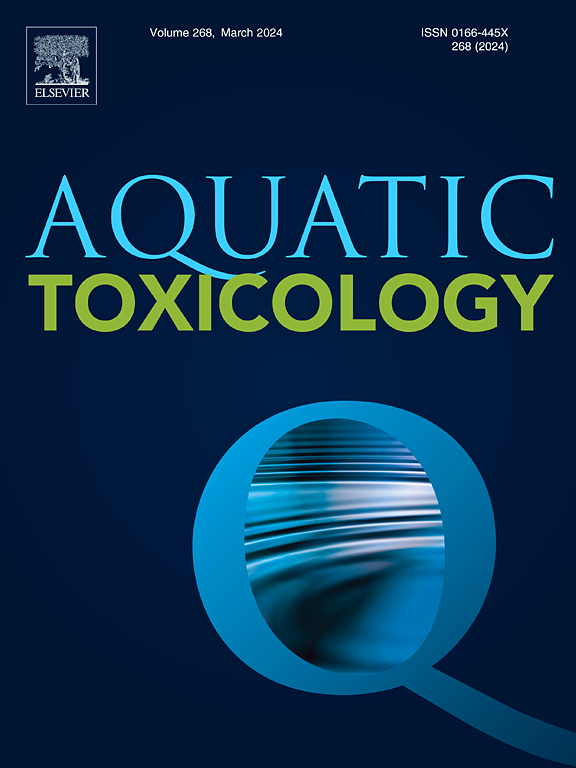大水蚤细胞培养物作为体外(生态)毒理学分析模型的建立:双酚a作为细胞毒性和内分泌干扰化学物的代表性案例研究
IF 4.1
2区 环境科学与生态学
Q1 MARINE & FRESHWATER BIOLOGY
引用次数: 0
摘要
双酚A (BPA)是一种广泛使用的工业化合物,存在于聚碳酸酯塑料、环氧树脂和各种聚合物材料中,导致其在环境中无处不在。BPA对水生生物的毒性在体内暴露后已被充分证明,具有已知的细胞毒性和内分泌干扰作用。因此,在本研究中,双酚a作为一种特性良好的化学物质,通过新的方法(NAMs)在毒性测试中实施更符合伦理和资源效率的科学实践。由于水蚤在毒理学研究中经常被用作模式生物,我们建立了水蚤大胚胎体外细胞培养体系,并优化了培养基以支持细胞寿命。培养物保存长达两个月,证明其稳定性和细胞毒性研究的适用性。利用这种新系统,测定了BPA暴露后24和48小时的致死浓度50 (LC50)值。随后,通过bpa暴露细胞的基因表达、活性测定和彗星测定来评估氧化应激、内分泌干扰和DNA损伤。分别计算52µM和20µM双酚a暴露24和48 h后的LC50值。暴露于20和52µM的BPA细胞显著增加GSH、GPx和GST活性水平。mRNA表达分析显示,BPA暴露后,hsp70、hsp90、gst、gpx、vtg1和cyp4的表达显著上调,sod、cat和ecr的表达下调。此外,彗星实验显示BPA引起的DNA损伤水平明显高于对照组,彗星和尾巴长度也更大。本研究建立了一种新的水蚤体外模型,以双酚a为案例研究确定毒性效应,进一步强调了通过减少动物使用来利用替代方法进行生态毒理学研究的重要性和适用性。本文章由计算机程序翻译,如有差异,请以英文原文为准。
Establishment of a cell culture from Daphnia magna as an in vitro model for (eco)toxicology assays: Case study using Bisphenol A as a representative cytotoxic and endocrine disrupting chemical
Bisphenol A (BPA) is a widely used industrial compound found in polycarbonate plastics, epoxy resin, and various polymer materials, leading to its ubiquitous presence in the environment. The toxicity of BPA to aquatic organisms has been well documented following in vivo exposure scenarios, with known cytotoxic and endocrine-disrupting effects. As such, BPA was used in this study as a well-characterized chemical to implement more ethical and resource-efficient scientific practices in toxicity testing through new approach methods (NAMs). Due to the frequent use of Daphnia spp. as a model organism in toxicology, we developed an in vitro cell culture system from Daphnia magna embryos, with optimized medium to support cell longevity. The cultures were maintained for up to two months, demonstrating their stability and suitability for cytotoxicity studies. Using this novel system, lethal concentration 50 (LC50) values were determined at the 24 and 48 h time points following BPA exposure. Subsequently, oxidative stress, endocrine disruption, and DNA damage were assessed through gene expression, activity assays, and a comet assay in BPA-exposed cells. LC50 values of 52 µM and 20 µM BPA were calculated after 24 and 48 h exposures, respectively. BPA cells exposed to 20 and 52 µM had significantly increased GSH, GPx, and GST activity levels. mRNA expression analysis revealed significant upregulations in the expression of hsp70, hsp90, gst, gpx, vtg1, and cyp4, with downregulations of sod, cat, and ecr following BPA exposure. Furthermore, comet assays showed a significantly higher level of DNA damage induced by BPA compared to controls, with greater comet and tail lengths. This study established a novel in vitro Daphnia model, using BPA as a case study for determining toxic effects, further highlighting the importance and applicability of utilizing alternative methods in ecotoxicological research through reducing animal use.
求助全文
通过发布文献求助,成功后即可免费获取论文全文。
去求助
来源期刊

Aquatic Toxicology
环境科学-毒理学
CiteScore
7.10
自引率
4.40%
发文量
250
审稿时长
56 days
期刊介绍:
Aquatic Toxicology publishes significant contributions that increase the understanding of the impact of harmful substances (including natural and synthetic chemicals) on aquatic organisms and ecosystems.
Aquatic Toxicology considers both laboratory and field studies with a focus on marine/ freshwater environments. We strive to attract high quality original scientific papers, critical reviews and expert opinion papers in the following areas: Effects of harmful substances on molecular, cellular, sub-organismal, organismal, population, community, and ecosystem level; Toxic Mechanisms; Genetic disturbances, transgenerational effects, behavioral and adaptive responses; Impacts of harmful substances on structure, function of and services provided by aquatic ecosystems; Mixture toxicity assessment; Statistical approaches to predict exposure to and hazards of contaminants
The journal also considers manuscripts in other areas, such as the development of innovative concepts, approaches, and methodologies, which promote the wider application of toxicological datasets to the protection of aquatic environments and inform ecological risk assessments and decision making by relevant authorities.
 求助内容:
求助内容: 应助结果提醒方式:
应助结果提醒方式:


